Examples of lane markings
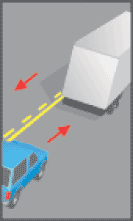
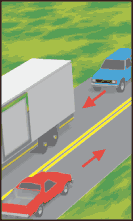
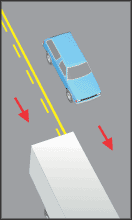
(1) Solid yellow line: No passing if solid yellow line is on your side.
(2) Double solid lines: DO NOT pass.
(3) Broken yellow line: May pass if movement can be made safely.
Line Colors
Solid yellow lines mark the center of a road used for two-way traffic.
Broken yellow lines indicate that you may pass if the broken line is next to your driving lane.
Two solid yellow lines indicate no passing. Never drive to the left of these lines unless you are:
- In a carpool lane/high occupancy vehicle (HOV) lane that has a designated entrance on the left.
- Instructed by construction or other signs to drive on the other side of the road because your side of the road is closed or blocked.
- Turning left across a single set of double yellow lines to enter or exit a driveway or private road, or make a U-turn.
Two sets of solid double yellow lines spaced 2 feet or more apart are considered a barrier. Do not drive on or over this barrier, make a left turn, or a U-turn across it, except at designated openings (see diagram).
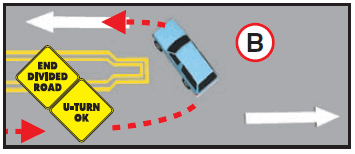
Solid white lines mark traffic lanes going in the same direction, such as one-way streets.
Broken white lines separate traffic lanes on roads with two or more lanes in the same direction.
Double white lines are two solid white lines that indicate a lane barrier between a regular use and a preferential use lane, such as a carpool/HOV. Never change lanes while in these lanes; wait until a single broken white line appears. You may also see these parallel lines in or near freeway on and off ramps.
Choosing A Lane
Traffic lanes are often referred to by number. The left or “fast” lane is called the “Number 1 Lane.” The lane to the right of the “Number 1 Lane” is called the “Number 2 Lane,” then the “Number 3 Lane,” etc.
Example of numbered traffic lanes
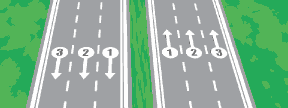
Drive in the lane with the smoothest flow of traffic. If you can choose among three lanes, pick the middle lane for the smoothest driving. To drive faster, pass, or turn left, use the left lane. When you choose to drive slowly, enter or exit traffic on the right, turn right, park, or move off the road, use the right lane. If there are only two lanes in your direction, pick the right lane for the smoothest driving. Do not weave in and out of traffic. Stay in one lane as much as possible. Once you start through an intersection, keep going. If you start to make a turn, follow through. Last minute changes may cause collisions. If you miss a turn, continue until you can safely and legally turn around.
Changing Lanes
Changing lanes includes:
- Moving from one lane to another.
- Entering the freeway from an on-ramp.
- Entering the road from a curb or the shoulder.
Before changing lanes, signal, look in all your mirrors, and:
- Check traffic behind and beside you.
- Look over your shoulder in the direction you plan to move to make sure the lane you want is clear.
- Check for vehicles, motorcyclists, and bicycle traffic in your blind spot.
- Be sure there is enough room for your vehicle in the next lane.
Passing Lanes
Before you pass, look ahead for road conditions and traffic that may cause other vehicles to move into your lane. Never drive off the paved or main- traveled portion of the road or on the shoulder to pass. The edge of the main-traveled portion of the road may have a painted white line on the road’s surface. Passing other vehicles at crossroads, railroad crossings, and shopping center entrances is dangerous.
Pass traffic on the left. You may pass on the right only when:
- An open highway is clearly marked for two or more lanes of travel in your direction.
- The driver ahead of you is turning left and you do not drive off the roadway to pass. Never pass on the left if the driver is signaling a left turn.
Carpool /High-Occupancy Vehicles (HOV) Lanes
An HOV lane is a special lane used only for carpools, buses, motorcycles, or decaled low-emission vehicles. You may use a carpool/HOV lane or on-ramp if your vehicle carries the posted minimum number of people required for the carpool lane, or you drive a low emission or a zero emission vehicle displaying a special DMV-issued decal. If you operate a low emission, zero emission, and/or hybrid vehicle, you may be exempt from all toll charges on high occupancy
toll (HOT) lanes. Motorcyclists may use designated carpool/HOV lanes, unless otherwise posted.
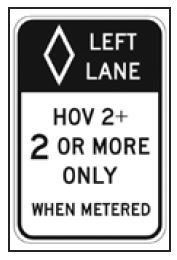
Signs at the on-ramp or along the freeway tell you the minimum number of people per vehicle required for the carpool/HOV lane(s). These signs also list the days of the week and the hours when the carpool/HOV requirement applies. The pavement in this lane is marked with a diamond symbol and the words “Carpool Lane.” These lanes are also known as HOV lanes. Do not cross over double parallel solid lines to enter or exit any carpool/HOV lane except at designated entry or exit places.
Center Left Turn Lanes
A center left turn lane is located in the middle of a two-way street and is marked on both sides by two painted lines. The inner line is broken and the outer line is solid. If a street has a center left turn lane, you must use it to prepare for or make a left turn, or to prepare for or make a permitted U-turn (CVC §21460.5 (c)). You may only drive for 200 feet in the center left turn lane. This lane is not a regular traffic lane or a passing lane. To turn left from this lane, signal, look over your shoulder, and drive completely inside the center left turn lane. Do not stop with the back of your vehicle blocking traffic. Make sure the lane is clear in both directions and then turn only when it is safe. Look for vehicles coming toward you in the same lane, preparing to start their left turn.
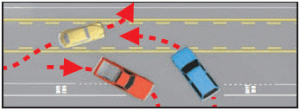
When turning left from a side street or driveway, signal and wait until it is safe. Then you may drive into the center left turn lane. Enter traffic only when it is safe.
Turnout Areas and Lanes
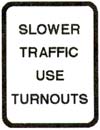
Special “turnout” areas are sometimes marked on two-lane roads. Drive into these areas to allow cars behind you to pass. Some two-lane roads have passing lanes. If you are driving slowly on a two-lane highway or road where passing is unsafe, and 5 or more vehicles are following, you must drive into the turnout areas or lanes to let the vehicles pass.
End-of-Lane Markings
Freeway lanes, as well as some city street lanes, which are ending will usually be marked by large broken lines painted on the pavement. If you are driving in a lane marked with these broken lines, be prepared to exit the freeway or for the lane to end. Look for a sign that tells you to exit or merge, etc.
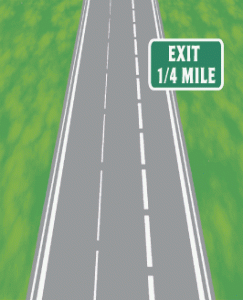
Yield Lines
Yield lines, also known as “shark’s teeth,” consist of a line of solid white triangles across a lane of traffic pointing towards approaching vehicles. This line indicates the point where the vehicle must yield/stop.

Bicycle Lanes
A bicycle lane is a designated traffic lane for bicyclists defined by pavement markings and signage. Bicycle lanes are sometimes painted a bright green color to increase visibility.
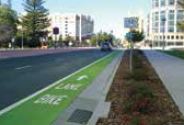
There are multiple classes and types of bicycle lanes, including:
- Bike Lane – Established along streets adjacent to vehicle traffic, typically defined by a single solid white line that turns into a dashed line near an intersection.
- Buffered Bike Lane – Provides greater separation from the adjacent vehicle traffic, as well as on-street parking, by using chevron or diagonal markings.
- Bike Route – A designated preferred route for bicyclists on streets shared with vehicle traffic, established by placing bike route signs and/or shared roadway markings.
- Bicycle Boulevard- A designated preferred route for bicyclists on streets shared with vehicle traffic, intended to prioritize bicycle travel.
- Separated Bikeway – Also known as a cycle track or protected bike lane, for the exclusive use of bicyclists, and physically separated from vehicle traffic. The separation may include flexible posts, grade separation, inflexible barriers, or on-street parking.
- Shared Roadway Bicycle Markings (Sharrows) – Alerts traffic that bicyclists are allowed to occupy this travel lane. When used appropriately, sharrows can also help bicyclists to maintain a safe lane position.

It is illegal to drive in a bicycle lane unless parking (where permitted), entering or leaving the roadway, or turning (within 200 feet of the intersection). Drivers of motorized bicycles should use caution to avoid bicyclists, and use bike lanes at a speed that is reasonable and does not endanger the safety of bicyclists.